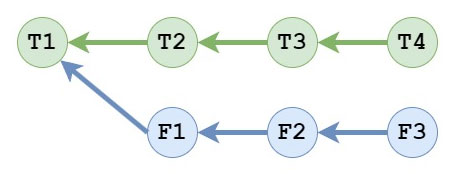September 11, 2022 • 106 mins
It’s time to understand the full power of Git’s rebase capabilities while Allen takes a call from Doc Brown, Michael is breaking stuff all day long, and Joe must be punished.
The full show notes for this episode are available at https://www.codingblocks.net/episode193.
News
- Thanks for the review Itsamritchahal!
- Want to help out the show? Leave us a review!
- Ludum Dare is a bi-annual game jam that’s been running for over 20 years now. Jam #51 is coming up September 30th to October 3rd. (ldjam.com)
- We previously talked about Ludum Dare in episode 146.
Branching and the power of rebase
- Every branch you work in typically has one or more base commits, i.e. the commits the branch started from.
git branchshows the branches in your local repo.git show-branchshows the branch ancestry in your local repo.- Reading the output from the bottom up takes you from oldest to newest history in the branches
- Plus signs, are used to indicate commits on divergent branches from the one that’s currently checked out.
- An asterisk, is used to indicate commits that happened on the current branch.
- At the top of the output above the dashed line, the output shows the branches, the column and color that will identify their commits, and the label used when identifying their commits.
- Consider an example repo where we have two branches,
TandF, whereT= Trunk andF= Feature and the commit history looks like this:
- What we want to do is bring Feature up to date with what’s in Trunk, so bring
T2,T3, andT4intoF3.- In most source control systems, your only option here is to merge, which you can also do in Git, and should be done if this is a published branch where we don’t want to change history.
- After a merge, the commit tree would look like this:
- The
F3'commit is essentially a “meta-commit” because it’s showing the work necessary to bringT4andF3together in the repository but contains no new changes from the working tree (assuming there were no merge conflicts to resolve, etc.)- If you would rather have your work in your Feature branch be directly based on the commits from Trunk rather than merge commits, you can do a
git rebase, but you should only do this for local development. - The resulting branch would look like this:
- If you would rather have your work in your Feature branch be directly based on the commits from Trunk rather than merge commits, you can do a
Popular Podcasts
Stuff You Should Know
If you've ever wanted to know about champagne, satanism, the Stonewall Uprising, chaos theory, LSD, El Nino, true crime and Rosa Parks, then look no further. Josh and Chuck have you covered.
24/7 News: The Latest
The latest news in 4 minutes updated every hour, every day.
The Joe Rogan Experience
The official podcast of comedian Joe Rogan.


 .css-j9qmi7{display:-webkit-box;display:-webkit-flex;display:-ms-flexbox;display:flex;-webkit-flex-direction:row;-ms-flex-direction:row;flex-direction:row;font-weight:700;margin-bottom:1rem;margin-top:2.8rem;width:100%;-webkit-box-pack:start;-ms-flex-pack:start;-webkit-justify-content:start;justify-content:start;padding-left:5rem;}@media only screen and (max-width: 599px){.css-j9qmi7{padding-left:0;-webkit-box-pack:center;-ms-flex-pack:center;-webkit-justify-content:center;justify-content:center;}}.css-j9qmi7 svg{fill:#27292D;}.css-j9qmi7 .eagfbvw0{-webkit-align-items:center;-webkit-box-align:center;-ms-flex-align:center;align-items:center;color:#27292D;}
.css-j9qmi7{display:-webkit-box;display:-webkit-flex;display:-ms-flexbox;display:flex;-webkit-flex-direction:row;-ms-flex-direction:row;flex-direction:row;font-weight:700;margin-bottom:1rem;margin-top:2.8rem;width:100%;-webkit-box-pack:start;-ms-flex-pack:start;-webkit-justify-content:start;justify-content:start;padding-left:5rem;}@media only screen and (max-width: 599px){.css-j9qmi7{padding-left:0;-webkit-box-pack:center;-ms-flex-pack:center;-webkit-justify-content:center;justify-content:center;}}.css-j9qmi7 svg{fill:#27292D;}.css-j9qmi7 .eagfbvw0{-webkit-align-items:center;-webkit-box-align:center;-ms-flex-align:center;align-items:center;color:#27292D;}